The Acrylic Pad Market is estimated to be valued at USD 4,938.2 million in 2025 and is projected to reach USD 6,766.5 million by 2035, registering a compound annual growth rate (CAGR) of 3.2% over the forecast period.
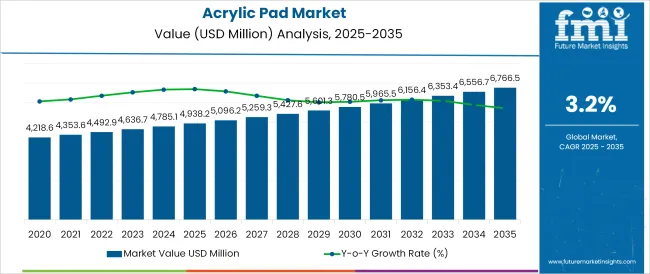
The acrylic pad market is experiencing stable growth, supported by the rising popularity of recreational art and the expanding number of hobbyists and professional artists. Industry publications and product launch updates have emphasized the growing consumer shift toward high-quality, versatile painting surfaces that support various acrylic techniques.
Educational institutions and art workshops have incorporated acrylic pads into their teaching materials, further broadening the user base. Manufacturers have responded to evolving artist preferences by developing pads with smoother textures, acid free sheets, and improved paper weight for optimal pigment retention.
Additionally, the influence of social media platforms has increased product visibility, with art influencers and educators promoting acrylic painting techniques and recommended materials. Market growth is expected to remain positive as product customization, eco-friendly manufacturing, and premium packaging trends gain traction. Segmental leadership is driven by the 9” x 12” size category, Painting as the primary activity, and the USD 25–USD 30 price range, reflecting the balance between product functionality, usability, and price affordability.
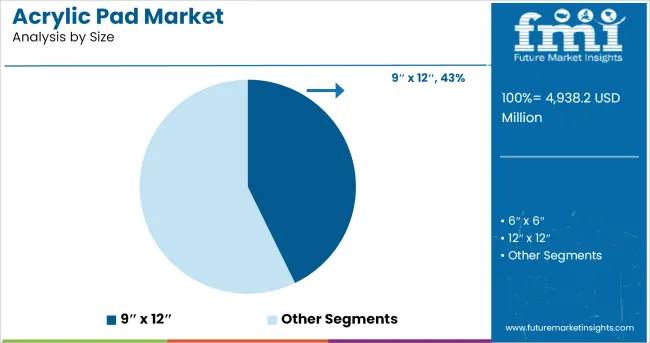
The 9″ x 12″ segment is projected to hold 42.8% of the acrylic pad market revenue in 2025, maintaining its leadership in product size categories. Growth in this segment has been attributed to its versatility and ease of handling, making it a preferred choice for both beginners and professional artists.
The size has been recognized as ideal for practice sessions, art classes, and creating artworks that are manageable in studio and on-the-go settings. Manufacturers have focused on producing pads in this format due to its compatibility with standard easels and framing options.
Consumer purchasing behavior has consistently favored the 9″ x 12″ format for its balance between surface area and portability. As demand grows for accessible art tools that cater to individual and institutional use cases, the 9″ x 12″ segment is expected to sustain its market share, supported by consistent adoption across educational and hobbyist sectors.
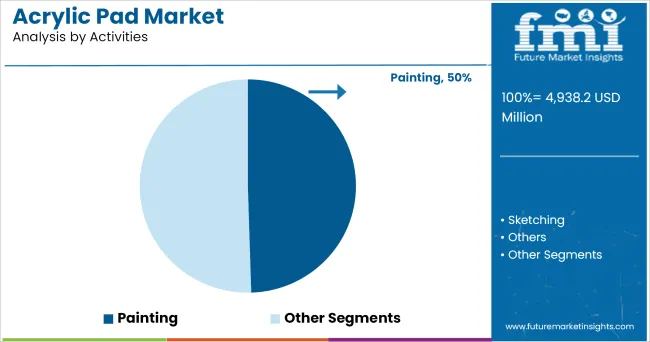
The Painting segment is projected to contribute 49.5% of the acrylic pad market revenue in 2025, securing its position as the dominant activity segment. Growth of this segment has been driven by the enduring popularity of acrylic painting among artists who seek a versatile medium for both fine art and decorative projects.
Art educators and studios have integrated acrylic painting sessions into their curriculum leading to sustained demand for pads specifically designed for this medium. Product features such as improved paper texture, enhanced absorbency, and durability against multiple paint layers have further driven segment growth.
Moreover, the rising trend of online art workshops and social media art challenges has motivated amateur artists to experiment with acrylics, boosting consumption of painting focused pads. With artistic expression continuing to gain cultural relevance and personal enrichment activities on the rise, the Painting segment is expected to remain the primary driver of demand in the acrylic pad market.
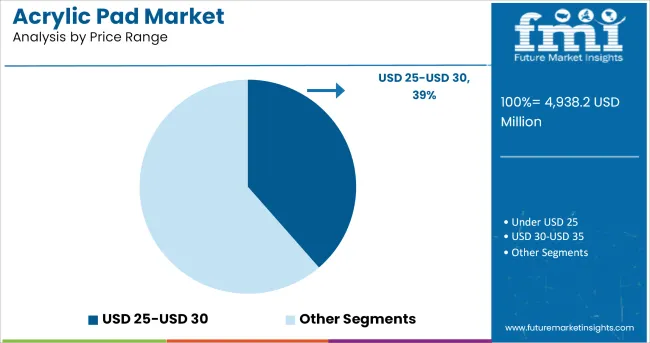
The USD 25-USD 30 price range segment is projected to account for 38.6% of the acrylic pad market revenue in 2025, reflecting its strong position as the preferred pricing tier. This price range has been favored by consumers seeking a balance between quality and affordability, particularly in mid-tier art supplies where both amateur and experienced artists look for value.
Manufacturers have introduced premium acrylic pads within this range, featuring archival-quality paper, reinforced binding, and eco friendly packaging, enhancing their appeal among discerning customers.
Consumer spending patterns have revealed consistent willingness to invest in durable, high-performance pads that support advanced painting techniques without paper warping or color bleed. Retail promotions and online art supply sales have further increased product visibility within this price range. As the market evolves, the USD 25–USD 30 segment is expected to maintain its competitiveness, driven by continuous product enhancements and the steady demand for reliable art materials.
Acrylic pad are in high demand due to rising consumer expenditure on paints. An acrylic pad is used by most artists, especially those who are just getting started with acrylic paints. Because it will be used with a thicker substance, the paper should be heavier to avoid warping.
The acrylic artist paper pad by Royal & Langnickel, for example, is 9 12 inches long and comprises 22 sheets. This thick, textured paper is suitable for watercolors, acrylic, gouache, and ink. These sheets are bonded at the top for a secure grip and a clean tear, and they're engineered to stay wrinkle-free even when painted over multiple layers.
Many industry competitors are developing it expressly for artists who have extremely specific requirements for acrylic painting pads. As a result consumers are even opting for eco-friendly acrylic pad which is encouraging the players in the market to design eco-friendly acrylic pad. For instance, Canson is a well-known brand for high-quality paint-friendly paper. The acid-free cold-press textured paper can withstand numerous washing. This pad contains 30 pages that are 11 x 15 inches in size.
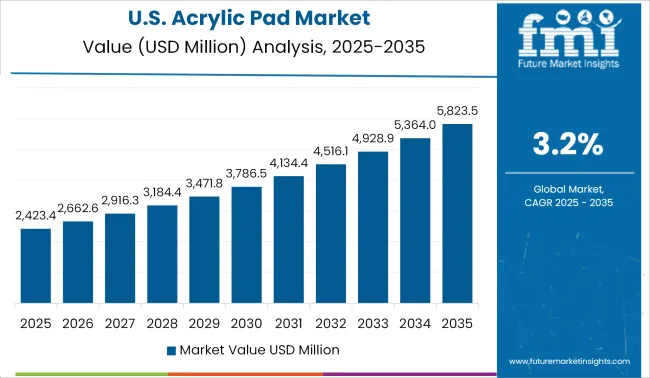
Previously, the United States was the world's largest paper producer. Americans place a high value on the arts. According to the majority of the inhabitants in the region, the arts boost personal well-being and help people comprehend other cultures.
On a personal level, they are frequently involved in arts such as painting. As a result, the region's need for acrylic pad is increasing. For instance, USA Art Supply develops Acrylic painting paper pads which has pack of two spiral pads containing 12 sheets each of 11 x 14-inch.
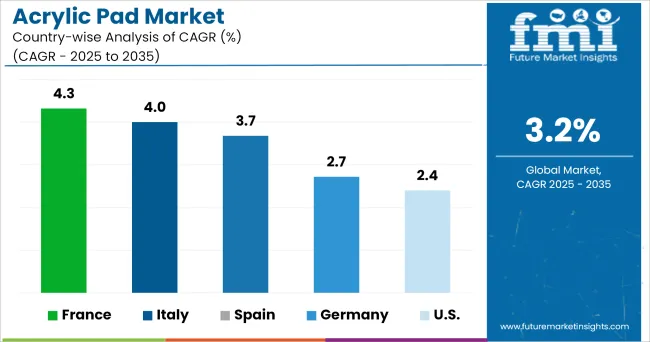
Europe's fine arts and culture are well-known. The creations of Europe's great artists are so well-known over the world that they may be identified immediately.
As a result of such outstanding artwork, people are encouraged to develop and paint art. As a result, due of its numerous benefits, it encourages artists to adopt acrylic pad. Furthermore, market participants are concentrating on providing the best acrylic pad.
Strathmore's acrylic pad, for example, is long-lasting, heavyweight, and perfect for acrylic painting. The textured surface with a linen finish keeps layers of paint that won't peel off or bleed through. This pad is acid-free and produced in France, and it comes in four different sizes.
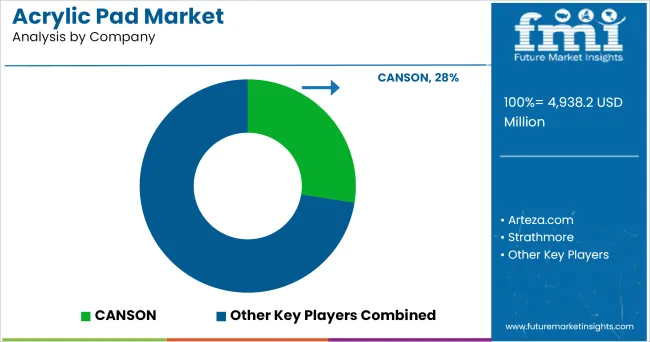
Some of the leading suppliers include
The report is a compilation of first-hand information, qualitative and quantitative assessment by industry analysts, inputs from industry experts and industry participants across the value chain. The report provides in-depth analysis of parent market trends, macro-economic indicators and governing factors along with market attractiveness as per segments. The report also maps the qualitative impact of various market factors on market segments and geographies.
The global acrylic pad market is estimated to be valued at USD 4,938.2 million in 2025.
The market size for the acrylic pad market is projected to reach USD 6,766.5 million by 2035.
The acrylic pad market is expected to grow at a 3.2% CAGR between 2025 and 2035.
The key product types in acrylic pad market are 9″ x 12″, 6″ x 6″ and 12″ x 12″.
In terms of activities, painting segment to command 49.5% share in the acrylic pad market in 2025.






Full Research Suite comprises of:
Market outlook & trends analysis
Interviews & case studies
Strategic recommendations
Vendor profiles & capabilities analysis
5-year forecasts
8 regions and 60+ country-level data splits
Market segment data splits
12 months of continuous data updates
DELIVERED AS:
PDF EXCEL ONLINE
Acrylic Paint Market Forecast and Outlook 2025 to 2035
Acrylic Fibre Market Size and Share Forecast Outlook 2025 to 2035
Acrylic Emulsions Market Size and Share Forecast Outlook 2025 to 2035
Acrylic Polymer Market Size and Share Forecast Outlook 2025 to 2035
Acrylic Resin Market Size and Share Forecast Outlook 2025 to 2035
Acrylic Fine Particle Market Size and Share Forecast Outlook 2025 to 2035
Acrylic Boxes Market Size and Share Forecast Outlook 2025 to 2035
Acrylic Paper Market Size and Share Forecast Outlook 2025 to 2035
Acrylic Adhesives Market Growth - Trends & Forecast 2025 to 2035
Acrylic Teeth Market Trends and Assessment for 2025 to 2035
Acrylic Styrene Acrylonitrile (ASA) Resin Market- Growth & Demand 2025 to 2035
Key Companies & Market Share in the Acrylic Airless Bottle Sector
Analyzing Acrylic Boxes Market Share & Industry Leaders
Acrylic Acid Market Growth - Trends & Forecast 2024 to 2034
Acrylic Airless Bottle Market Trends - Demand & Forecast 2024 to 2034
Acrylic Colors Market
Acrylic Container Market
Acrylic Lenses Market
Acrylic Foam Tapes Market
Cast Acrylic Sheets Market Size and Share Forecast Outlook 2025 to 2035

Thank you!
You will receive an email from our Business Development Manager. Please be sure to check your SPAM/JUNK folder too.
Chat With
MaRIA